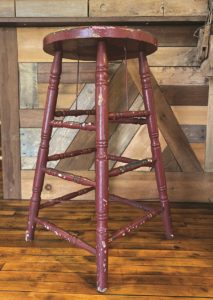I recently bought my first-ever brand-new piece of furniture. It is a chartreuse sectional couch and I love it an unreasonable amount. I sit on it, I lie on it, I stand back and admire it, and I regularly check to see if I — or anyone else — has spilled any soy sauce on it.
As steps into adulthood go, this one seems official. Doing my taxes? Whatever. Kind of understanding health insurance? Over it. But buying an expensive piece of furniture? Oh, yeah, I’ve made it. This must be what it feels like to have an IRA account. What a high, what a rush, what a gorgeous, tangible indication that I am finally living my fullest adult life.

As I sit on my mid-century modernesque throne and observe my home-kingdom, I am struck by the persistent presence of a few artful pieces my boyfriend and I have accumulated from nontraditional venues. They still catch my eye.
Part of the reason is that they have had past lives. These are pieces left by a previous occupant of this home, scooped up from the Methodist Thrift Store, or wrangled off the Swap Meet Facebook group. They have bumps and bruises, but also charm. They are a reminder that you don’t need to get something shiny and new to have something of value.
That being said, there is a lampshade or two that need to go.
On my right, the first second-hand treasure in view from my new sofa is the “stacking rock” lamp. Originally crafted by the brother of a previous roommate, its unique design and gentle tilt remind me of a soothing water sculpture. Though that thought is fleeting. Because, in actuality, it is a feat of balanced electricity, whose genuine instability makes it thrilling to use. Turning it on and off without making it wobble requires a gentle touch. Unsecured and gently resting on top, the thrifted shade is a reminder that, with a little patience and a willingness to readjust, things that don’t quite fit in can still be beautiful. I have never seen a lamp quite like it.

In the kitchen, the counter stools provide our home with even more eclectic flair. They are all of different makes, heights, colors, and levels of structural integrity. My favorite is the shortest of the stools, with a glossy wooden seat and forest green legs. It is the perfect height for the counter and is sturdy and stable. When I am feeling a little more adventurous, though, I take to the turned maroon perch snagged from the local thrift shop. Its design is reminiscent of old banisters, with an almost Victorian feel. The colorful, textured history of the stool becomes apparent if you look intently at its chipping paint. While the current color is a warm maroon, hints of white, green, pink, and brown peek through. There are some who would have sanded and repainted it by now, but if you ask me, it doesn’t need to be given a new life. It is already living.
Sometimes, the imperfections of a scavenged item are a little more trouble than you’ve bargained for. My desk, having been hastily claimed on Swap Meet and wrestled into our home, found itself wedged in the doorway. It stayed there a good long while, unmoving, baring its underbelly and taunting me. Its L-shaped construction, so unique that it felt impossible to pass up on first glance, was a liability. It was deconstructed with a saw and rebuilt once it had passed through the door.
In my past pre-couch, pre-true-adult life, a setback of this nature might have made me impatient. The desk left on the curb with a “Free — please take me!” sign taped on top. But the now grown-up me knows a little bit of struggle is inevitable when taking on anything (or anyone) that exhibits valuable idiosyncrasies. The sense of accomplishment that comes with overcoming that makes thrift shop finds so valuable.



